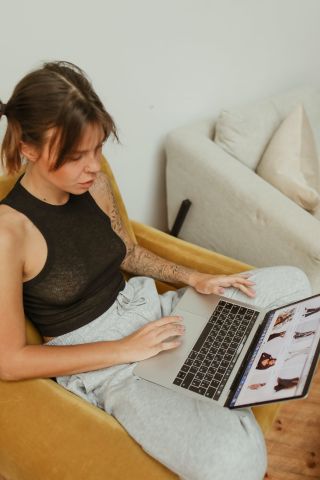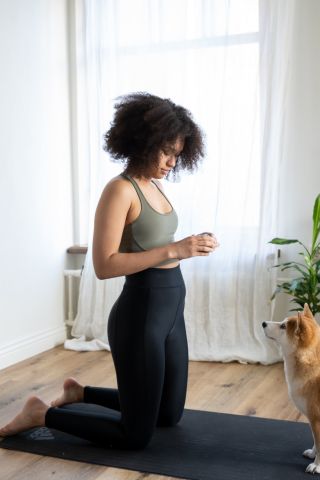Body Image
Online Shopping Can Be a Blow to Body Image
New studies find browsing for clothes online reduces self-esteem and body image.
Posted December 17, 2023 Reviewed by Jessica Schrader
Key points
- A new study found that online shopping for activewear may have an especially negative impact on body image.
- When the clothing you’re shopping for tends to be revealing, body comparisons can be even more detailed.
- Though the effects were small, women who do a lot of online shopping might experience a more serious impact.

When researchers began studying the link between women's body image and images of women in the media, the focus was on fashion magazines, movies, and television programs. More recently, scientists have studied the impact of social media imagery on women’s body image. But a new study out of Australia takes on the impact of a relatively ignored source of exposure to highly edited media images of women: online shopping websites. In this study, researchers found evidence that online shopping for a particular category of clothing—activewear—may have an especially negative impact on women’s body image and self-esteem.
At this point, it’s widely acknowledged that media images of women tend to feature a body and beauty ideal that is unattainable for most women. Advertisers in particular tend to start with a group of models who are much taller, thinner, and younger than most women. They then Photoshop and otherwise edit the images of these women until they look very little like a woman you could actually see in everyday life. Looking at these types of images tends to worsen mood and body image, as women compare themselves to an ideal against which they will almost always fall short. Unfortunately, knowing that images are edited doesn’t seem to prevent these negative outcomes.

Because retailers selling apparel are motivated to make their clothing look as attractive as possible, they will typically select models with the types of bodies most prized by our culture. Though some clothing brands have made progress in terms of using models with more body size diversity, most models featured on websites selling clothing still tend to be very thin. Retailers also frequently show models in poses that highlight sexualized body parts like the butt or breasts, as doing so seems to increase attention to the images.
Images of models in activewear (think sports bras, yoga pants, and other clothing that could be worn for working out) may have an especially strong impact on women’s body image. Unlike shopping for clothing in a brick-and-mortar store where most garments are hung on racks or folded on shelves, women shopping for clothing online see apparel on models and must compare their own body to a model’s body to determine how that article of clothing would look on them. When the clothing you’re shopping for tends to be revealing—like activewear—these body comparisons can be even more detailed, focusing you on areas of your body with which you might be dissatisfied.
In two new studies, researchers examined how much time women spend online shopping for various types of clothing and whether online clothing shopping might worsen women’s body image. The first study involved an online survey of nearly 400 women between the ages of 18-70. Eighty-one percent of women reported browsing online for clothing in the past month. Though women spent the most time shopping for casualwear, activewear shopping came in a close second. Overall, the more time women spent browsing for clothing online, the worse they felt about their bodies and the more they tended to compare their appearance with others. Women who spent a lot of time browsing for clothing online also reported more body surveillance, which is a term that refers to monitoring how your body looks to other people.
In a second study, 126 women completed a lab-based experiment in which researchers randomly assigned each woman to spend 15 minutes browsing one of three online shopping websites. The "control” website was a housewares website that featured furniture and home décor, but very few images of models. The casualwear website featured models who tended not to be sexualized or shown in highly revealing clothing. For example, the homepage at the time of the study showed women from the waist up in long-sleeved button-down shirts and jackets. The activewear website featured models in typical activewear and often in sexualized poses. The homepage for this website at the time of the study showed one model in workout tights with her back to the camera and back arched to emphasize her butt, as well as models who were lifting up their shirts to reveal their abdomens. Both immediately before and immediately after browsing their assigned website, women completed a mood measure, a measure of self-esteem, and a measure of body satisfaction.
Though the researchers predicted that browsing for apparel might negatively affect women’s mood, they instead found that the 20 minutes spent online shopping tended to improve women’s mood—regardless of whether they were browsing for housewares, casualwear, or activewear. In other words, women seemed to find the shopping enjoyable, even though it was “fake” shopping.

However, browsing the activewear website significantly reduced women’s body satisfaction and self-esteem. Though the effects were small, the women in the study spent a relatively limited amount of time browsing. For women who do a lot of online shopping, these types of small effects might accumulate into a more serious impact on body image and self-esteem. The take-home message of the study is fairly straightforward. If body image is something you struggle with, try to limit the time you spend shopping online, particularly on sites that feature models in revealing clothing and sexualized poses. Online shopping might be fun and result in a brief mood boost, but the longer-term self-esteem penalty may be too high a price to pay.


